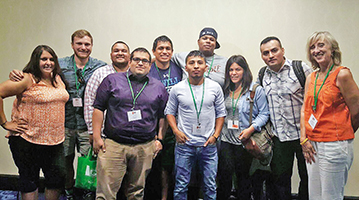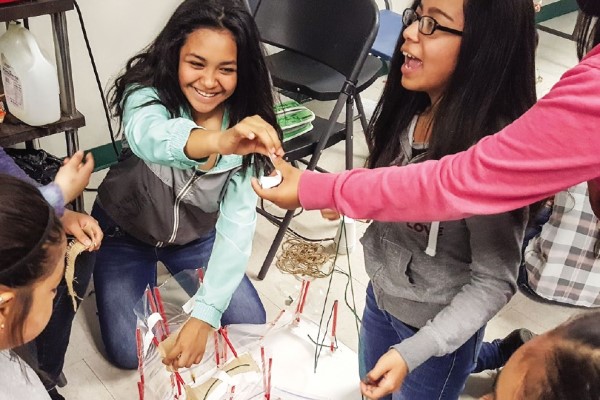Bridging the STEM Gap for Rural Students
May 01, 2017

The need to prepare young students for STEM careers is urgent. That’s even true in Washington state, ranking fourth nationally for technology-based corporations as home to Microsoft, Boeing, Amazon and many smaller employers. STEM is serious business in our state.
An estimated 45,000 STEM-related jobs in Washington will go unfilled in 2017. The successful new employees are likely to come from outside the state. Washington ranks 46th nationwide for students participating in science and engineering graduate programs and remains a major net importer of bachelor- and graduate-level STEM professionals.
Washington’s STEM employers seek more well-prepared local applicants. What’s needed are more students in the pipeline, and that means students from the many rural communities.
Collaborative Avenues
For students in Washington’s rural school districts, the hurdles to meet the demands of STEM employers are high. Rural students have limited access to rigorous STEM coursework. Smaller student populations mean low enrollments in Advanced Placement and International Baccalaureate courses, making them hard to justify and staff. Important courses may be offered only once in two years, if at all. Small, geographically isolated towns offer few STEM role models and mentors.
With tight budgets, uncompetitive salaries and isolated communities far from big-city amenities, rural school districts struggle to recruit and retain qualified teachers. An additional instructional challenge comes from the fact our state has the third-highest percentage of rural English language learners in the nation. Most are Spanish-speaking, from agricultural families whose livelihoods connect them to the state’s fields, orchards and vineyards. Too often, these students have not benefitted from a strong academic preparation.
What can rural education leaders do to address these challenges? Based on our experiences in rural Washington, quite a few options exist.
First, school system leaders must realize they don’t have to go it alone. In Washington state, projects known as GEAR UP, funded by the U.S. Department of Education, connect University of Washington, Washington State University, Central Washington University and education nonprofits with more than 34 rural school districts serving 25,000 students in the central and eastern regions with postsecondary outreach services that focus on STEM. Through these partnerships, small districts have been able to put in place meaningful curricular innovations, STEM events and summer camps — all of which inspire students to prepare for careers in STEM fields.
“One small example of the value of our partnership with Central Washington University was a career night where we brought back one of our own graduates who now works for an aerospace company,” said Scott Ramsey, principal of Quincy Junior High School in Quincy, Wash. “He told our students that people like them are currently employed in cool STEM fields.”
Building Rigor
Strong academic preparation remains key to students’ STEM readiness. Using various strategies, our rural district partners are working to enhance classroom academic press — a culture of high expectations, strong aspirations and rigorous academics — in math, science and English.
To address the differing needs of their students, school districts such as Oroville, Chelan, Wenatchee and others in the eastern half of Washington have adjusted daily schedules to allow teachers to differentiate instruction. While some students engage in remedial learning, others pursue more rigorous work, including projects involving science and technology.
The proximity of middle schools and high schools to each other in rural settings enables unique collaboration. This fall in Tonasket, the middle school robotics teacher will offer a new high school robotics class extending the two sections now offered at the middle school.
High school juniors and seniors in Washington can accumulate up to two years of college credits — punching up their transcripts and enabling them to begin their university studies as juniors. An increasing number of Washington’s rural students are taking advantage. Rural students in the 10-district Central Washington University GEAR UP consortia are earning more than twice as many college credits as they did four years ago.
Some rural districts are expanding their AP course offerings, despite low enrollments, by carefully designing single classes that offer both college-in-the-high school and general education credits.
All of this takes highly dedicated teachers and creative administrators, but you will find these educational heroes and heroines in many rural schools, working to level the playing field for their students in the college access game.
Sparking Passion

Helping districts strengthen math and science curricula is critical, but this work must be accompanied by efforts to inspire students’ passion to pursue STEM. Our programs build student interest in STEM careers, promote and support the required academic rigor and engage students in real-world STEM projects. All are necessary for student success.
Rural communities also are helping out. The small local cinemas in Omak and Chelan in central Washington have opened their theaters to show the first-run film “Hidden Figures” to entire classes of students from Omak, Tonasket, Chelan and Manson, helping dispel the stereotype that only white males have a role in STEM careers.
Another necessity is time. To ensure more students complete AP math and science, we push for strong preparation in middle school. “We know STEM jobs are demanding, but we believe in our students and stand behind them to build the skills they need for careers to which they aspire,” says Barry DePaoli, Lake Chelan School District superintendent. “That means starting earlier, in elementary and middle school.”
Districts making inroads in STEM learning provide support to students through after-school tutoring, access to technology and careful academic case management.
Show, Not Tell
How do you motivate middle schoolers to this hard work? Rural students tend to be practical. Rather than telling them, we show them why STEM learning is important and how they can do it. Our activities are designed to “catch” them being scientists and engineers, to draw on their own experiences and abilities so they see themselves in and become excited about STEM careers.
We engage our 8th graders in this real-world STEM scenario: In Mali, West Africa, political unrest has forced thousands of small farmers and their families to flee their land for safety in Bamako, the nation’s capital. The overwhelmed city is unable to feed its people. It now is full of unemployed farmers.
The assignment is this: Using only detritus available on Bamako streets — broken pallets, plastic bags, water bottles, rope and cloth — students work in teams to design vertical gardens for the displaced farmers to grow food to feed their families or sell to others. The assignment draws on students’ agricultural roots and funds of knowledge. The problem is complicated and there is no single, elegant solution. As such, each team’s answer is valid. And students actually work as engineers — they address a societal need, observe resource constraints and through trial and error fashion solutions.
Another unconventional activity introduces students to health care professions, which are high-demand careers in rural areas. In partnership with university faculty and graduate students, we’ve created Zombie Apocalypse, a collection of learning activities using curricula from the Centers for Disease Control and the American Red Cross. Through simulations of zombie invasions, students act as medical technicians, learning about blood-borne pathogens and how to protect communities from infectious diseases. They get a primer in public safety as they develop evacuation plans to protect their town from a zombie incursion. This highly engaging fiction helps us build interest in myriad health care careers. It’s also fun — what kid doesn’t love a good zombie attack?
A Postsecondary Bridge
Nearly all STEM professions require diplomas from universities, community colleges or technical colleges. When we take students on college tours, our university partners make sure each visit includes a STEM orientation.
Admissions officers from our university partners urge us to get our students as academically prepared as possible for college-level expectations. They also recognize rural school challenges. They advise students to collect evidence of STEM knowledge and commitment. Such evidence can help admissions officers advocate for students whose academic performance may not otherwise be competitive.
One artifact we’ve developed are digital badges awarded for completion of STEM activities. The badges, akin to Eagle Scout badges, are stored online in students’ files, ready to be accessed for students’ postsecondary admissions. (See School Administrator’s January 2017 issue.)
Short-Term Benefits
No single strategy will unleash a torrent of astronauts and engineers from rural schools, but we can create realistic STEM opportunities for future generations while improving prospects for current students. GEAR UP and similar partnerships, which operate in every state and uniquely engage K-12, postsecondary education and communities, can help identify and strengthen multiple STEM career paths for rural learners.
Rural students may need more time to compete successfully with their better-resourced suburban peers. Time is on their side. They may enjoy a 90-year lifespan during which they will retool for jobs that do not now exist. With our state’s robust community college system and through federal partnerships such as GEAR UP bridging the K-12 and postsecondary sectors, we can define and strengthen multiple STEM career paths for rural students and extend the timetable for entering university programs, keeping students’ eyes on the prize.
Rural education leaders can help students each find the path to lifelong passions, including careers in science, technology, engineering and math. What’s needed is a willingness by educators to work hard, think creatively, find partnerships and try new things — yes, the same things we ask of students.
Author
Additional Resources for Rural STEM
Barbara Peterson says these websites and publications offer practical help for smaller, rural schools eager to expand STEM learning.
Websites
- American Red Cross’s Zombie Apocalypse Party
- American Society for Engineering Education
- Centers for Disease Control and Prevention’s Zombie Preparedness and Preparedness 101: Zombie Pandemic, a graphic novel
- Credly digital badge platform
- GEAR UP Project
- Museum of Science, Boston: Engineering Everywhere middle school curriculum
- Northwest Learning and Achievement Group
- The RECON Project: Research and Education Collaborative Occultation Network
- VEX Robotics program
- VEX Robotics curriculum and industry certifications
Publications
- “Attributes of a Global Engineer,” Global Engineering Deans Council
- “Designing Engineering Experiences to Engage All Students,” Engineering in Pre-College Settings: Synthesizing Research, Policy and Practices, by C.M. Cunningham and C.P. Lachapelle
- “Rural Students in Washington State: STEM as a Strategy for Building Rigor, Postsecondary Aspirations and Relevant Career Opportunities” by B. Peterson, G. Bornemann, C. Lydon and K. West, Peabody Journal of Education, Vol. 90, Issue 2, 2015
Advertisement
Advertisement
Advertisement
Advertisement



